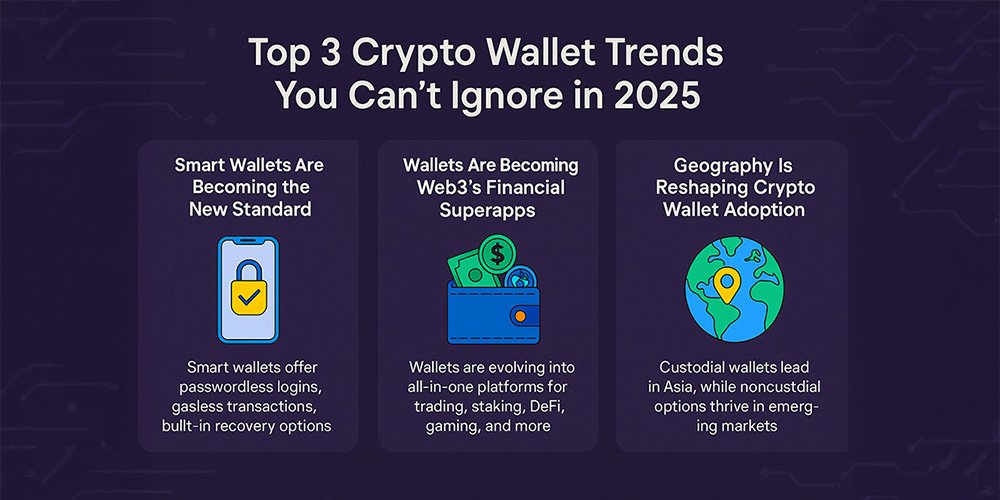In 2025, crypto wallets have evolved far beyond simple storage tools—they’ve become the beating heart of Web3. A new report from Dune Analytics and Addressable.io highlights how these wallets are transforming user experiences, financial tools, and global crypto adoption strategies.
Here are the three key trends you need to know:
1. Smart Wallets Are Becoming the New Standard
Smart wallets are no longer a novelty—they’re emerging as the default for modern crypto users. These wallets are powered by account abstraction (like ERC-4337) and offer features such as:
- Passwordless logins
- Gasless transactions
- Built-in wallet recovery options
The report shows explosive growth in platforms like Coinbase Smart Wallet, which jumped from 15,000 to over 40,000 weekly active users between January and April 2025—thanks to its integration with Base, Coinbase’s Layer 2 network. In fact, Base now processes 87% of smart wallet transactions, becoming the go-to network for efficient, low-cost operations.
Although Safe leads in total smart wallet deployments with 43 million accounts, many are background implementations. In contrast, Coinbase is seeing more direct user engagement with a growing 60% retention rate—highlighting the shift toward wallets designed for real consumer interaction.
Today’s wallets don’t just hold crypto—they serve as all-in-one platforms for:
- Token swaps
- Staking rewards
- Cross-chain bridging
- DeFi services (like lending and borrowing)
- Blockchain gaming
For example:
- Binance Wallet now facilitates over 33 million token swaps per week, worth nearly $9 billion.
- Phantom Wallet, tailored for Solana, handles 10 million weekly swaps, driving nearly 20% of the network’s traffic during peak periods.
Infrastructure platforms like Privy are also streamlining onboarding, letting developers integrate wallets in under 200 milliseconds—making wallet-native apps more accessible to newcomers.
And with AI agents now having their own wallets, automation is expanding into decentralized finance as well.
3. Geography Is Reshaping Crypto Wallet Adoption
The report also reveals clear geographic divides in wallet usage:
- In Asia, custodial wallets like OKX and Bitget dominate due to ease-of-use and trusted local brands.
- In emerging markets such as Nigeria, India, Indonesia, and Vietnam, non-custodial wallets like MetaMask and Phantom lead the way—highlighting rising adoption in regions with fewer financial alternatives.
However, most capital is still concentrated in developed markets like the U.S., South Korea, and Europe. This contrast suggests that wallet providers need dual strategies: mass-user growth in emerging markets and capital-focused services in wealthier regions.
According to Addressable’s co-founder Asaf Nadler, this is the first study to analyze over 15 million wallet users across 20 platforms, providing deep behavioral insights that could shift how wallet providers target their growth.
Crypto Wallets Are Leading the Web3 Revolution
Wallets are no longer side tools—they’re central to how users experience blockchain. With smart functionality, financial integrations, and a clear path toward global adoption, wallets are becoming the main gateway into the crypto ecosystem.
As new standards like Ethereum’s EIP-7702 roll out, even traditional wallet users will be able to upgrade to programmable, smarter versions—bringing us closer to a future where wallets are as intuitive as mobile banking apps.
In short: wallets are no longer just evolving—they’re shaping the mainstream future of crypto.

